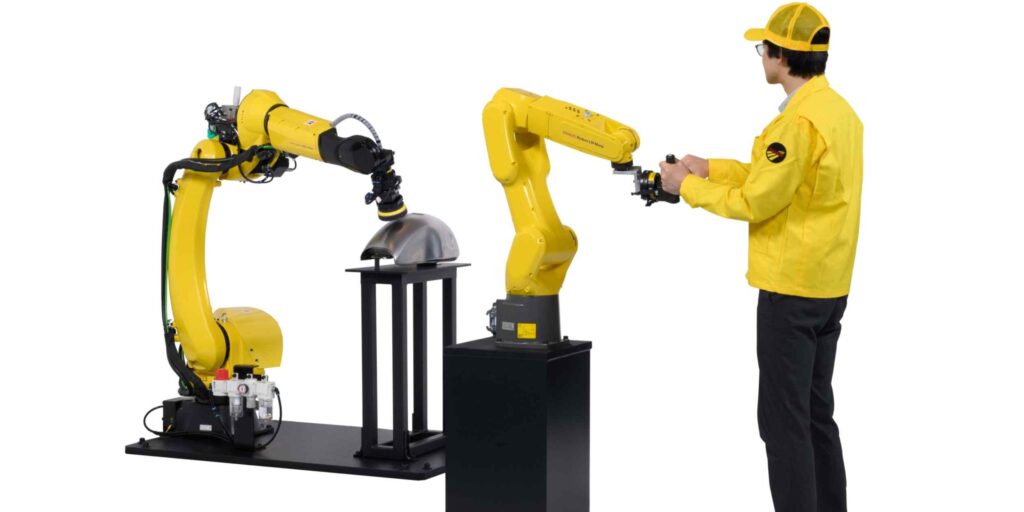Revolutionizing Automation with Fanuc’s Robot Arm
Introduction to the New Robot Arm System
TOKYO — Fanuc has unveiled a groundbreaking robot arm system that revolutionizes the way automation can assist in dangerous or complex tasks. This innovative technology remotely duplicates the movements of skilled workers, potentially transforming industries where automation has been difficult to implement.
Understanding the Technology Behind the System
The core of this robotic system consists of two key components: the “leader” arm and the “follower” arm. The leader arm is operated by the user through a handheld controller, allowing for intuitive interaction. In contrast, the follower arm mirrors the actions taken by the leader arm, creating a seamless connection between human and machine.
How Force Feedback Enhances Performance
Equipped with advanced sensors, the follower arm can detect the force being applied to the object it manipulates. This information is relayed back to the leader arm, providing the user with simulated touch and resistance. As a result, operators can make precise adjustments to their movements, significantly improving accuracy and safety.
Applications in High-Risk Environments
The implications of this technology reach far and wide, particularly in industries where manual tasks pose high risks. The ability to safely replicate the actions of skilled workers means that tasks previously deemed too hazardous can now be automated, enhancing both productivity and worker safety.
Benefits of Remote Operation
By enabling remote operation, Fanuc’s robot arm system allows skilled workers to perform tasks from a safe distance. This feature is invaluable in sectors such as manufacturing, healthcare, and hazardous environments, where direct human intervention is often risky or impractical.
Conclusion: The Future of Robotics and Automation
As automation technology continues to evolve, Fanuc’s innovative robot arm system exemplifies the potential of robotics to augment human capabilities. The fusion of force feedback with robotic automation not only enhances efficiency but also prioritizes workplace safety, setting a new standard for the industry.
Looking Ahead
With continued advancements, Fanuc’s developments in robotic technology could redefine how industries approach automation. As businesses begin to embrace this technology, it will be interesting to witness the evolution of workplace dynamics and the increasing role of robotics in everyday tasks.
Revolutionizing Automation with Advanced Robotic Arm Technology
In the realm of technological advancements, the development of robotics has taken significant strides. One of the latest breakthroughs is a state-of-the-art robotic arm system designed to enhance automation in industries where manual labor proves both challenging and hazardous. This innovative approach combines human skill with robotic precision, paving the way for safer work environments and increased productivity.
Understanding the Robotic Arm System
The advanced robotic arm system is a remarkable composition of two distinct components: the “leader” arm and the “follower” arm. The leader arm is operated by an individual, utilizing a handheld controller, while the follower arm directly mimics the movements of the leader. This synchronized operation ensures a seamless interaction between human input and robotic response, creating a dynamic system that can adapt to various tasks.
Force Feedback Mechanism
At the core of this robotic system lies a sophisticated force feedback mechanism. The follower arm is equipped with sensors that detect the force exerted on the objects it manipulates. These sensors relay critical information back to the leader arm, allowing the operator to feel and adjust the amount of resistance encountered during the task. This simulates a natural tactile experience, empowering users to perform complex operations with greater confidence and control.
Applications of the Robotic Arm System
The versatility of this robotic arm technology opens up a myriad of applications across various industries. From manufacturing to healthcare, the ability to automate tasks that require intricate handling is invaluable. Industries where safety is paramount, such as hazardous material handling or heavy machinery operation, significantly benefit from this technology, minimizing the risk of human error and injury.
Enhancing Safety Through Automation
Safety is at the forefront of industrial innovation, and this robotic arm system exemplifies that principle. By allowing skilled workers to control the robotic arm from a distance, the system mitigates the risks associated with performing dangerous tasks manually. Workers can maintain a safe distance from hazardous environments while still ensuring high-quality output through the robotic follower arm.
Increasing Efficiency and Productivity
In addition to enhancing safety, the robotic arm system significantly boosts efficiency and productivity. By combining human ingenuity with robotic execution, tasks can be completed faster and with greater precision. This not only reduces operational downtime but also allows businesses to allocate resources more effectively, driving overall growth and innovation.
The Future of Robotics and Automation
As robotics technology continues to evolve, the integration of advanced systems like the robotic arm showcases the potential for transformation across industries. With ongoing research and development, we can anticipate even more sophisticated applications that will further bridge the gap between human skill and robotic reliability. Embracing such innovations will be crucial for businesses aiming to stay competitive in an increasingly automated world.
Conclusion
The development of a robotic arm system that combines human control with advanced feedback technology presents a promising leap towards the future of automation. By enhancing safety and productivity, this innovative solution addresses the critical challenges faced in various industries. As we look ahead, the collaboration between humans and robots will undoubtedly redefine the landscape of work and manufacturing, paving the way for a safer and more efficient world.


